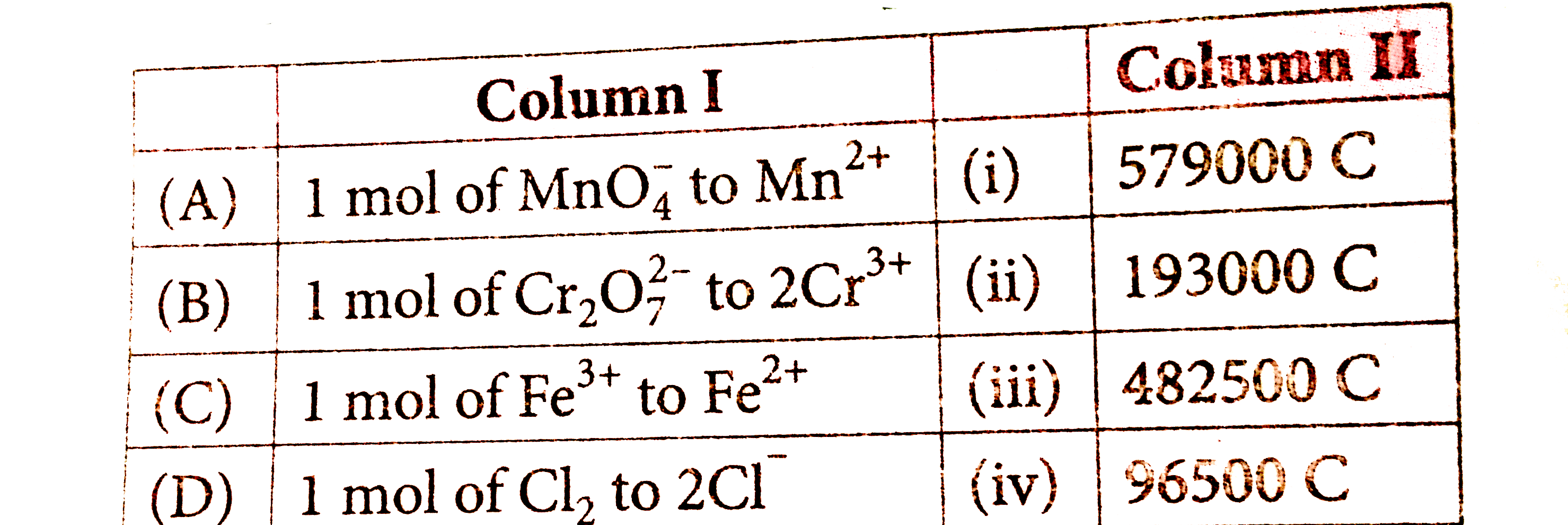Standard electrode potential of two half-reactions are given below:
Fe2+⇔Fe,E∘=−0.44V
Fe3+⇔Fe2+,E∘=+0.77V
If Fe2+,Fe3+ and fe are kept together:
Fe3+ increases
Fe3+ decreases
Fe2+ increases
Fe2+ decreases
The correct Answer is:B, C
Fe2++Fe2+→Fe3++Fe (non spontaneous)
Topper's Solved these Questions
- ELECTROCHEMISRYBOOK - RESONANCE ENGLISHCHAPTER - ELECTROCHEMISRYEXERCISE - CBSE Problems
34 Videos
- ELECTRO CHEMISTRYBOOK - RESONANCE ENGLISHCHAPTER - ELECTRO CHEMISTRYEXERCISE - PHYSICAL CHEMITRY (ELECTROCHEMISTRY)
53 Videos
- EQUIVALENT CONCEPT & TITRATIONSBOOK - RESONANCE ENGLISHCHAPTER - EQUIVALENT CONCEPT & TITRATIONSEXERCISE - Part -IV
22 Videos
Similar Questions
Standard electrode potentials are
Fe2+/Fe,E∘=−0.44V
Fe3+/Fe2+,E∘=+0.77V
If Fe3+,Fe2+, and Fe block are kept together, then
View SolutionGiven that E.Fe2+/Fe=−0.44V,E∘Fe3+/Fe2+=0.77V if Fe2+,Fe3+ and Fe solid are kept together then
View SolutionGiven Ec−.Fe2+∣Fe and Ec−.Fe3+∣Fe2+ are −0.44 and 0.77V respectively.
If Fe2+,Fe3+ and Fe blocks are kept together, then
View SolutionThe standard electrode potential of the half cells are given below :
Zn2++2e−→Zn(s),Eo=−7.62V
Fe2++2e−→Fe(s),Eo=−7.81V
The emf of the cell Fe2++Zn→Zn2++Fe will be :
View SolutionStandard electrode potential data is given below :
Fe3+(aq)+e−→Fe2+(aq),Eo=+0.77V
Al3+(aq)+3e−→Al(s),Eo=−1.66V
Br2(aq)+2e−→2Br−(aq),Eo=+1.08V
Based on the data given above, reducing power of Fe2+ Al and Br− will increase in the order :
View SolutionThe standard oxidation potentials, , for the half reactions are as follows :
Zn→Zn2++2e− ,E∘=+0.76V
Fe→Fe2++2e−,E∘=+0.41V
The EMF for the cell reaction,
Fe2++Zn→Zn2++Fe
View SolutionCopper from copper sulphate solution can be displacesd by. (The standard reduction potentials of some electrodes are given below):
Eo(Fe2+/Fe)=−0.44V,Eo(Zn2+/Zn)=−0.76V
Eo(Cu2+/Cu)=+0.34V:Eo(Cr3+/Cr)=−0.74V
Eo(H+/12H2)=0.00V
View SolutionThe standard reduction potentials at 298K for the following half cells are given :
ZN2+(aq)+2e−Zn(s), E∘=−0.762V
Cr3+(aq)+3e−Cr(s), E∘=−0.740V
2H+(aq)+2e−H2(g), E∘=0.000V
Fe3+(aq)+e−Fe2+(aq), E∘=0.770V
which is the strongest reducing agent ?
View SolutionStandard electrode potentials of few half-cell reactions are given below :
MnO−4+8H++5e−→Mn2++4H2OE∘=1.51VCr2O2−7+14H++6e−→2Cr3++7H2OE∘=1.33VFe3++e−→Fe2+E∘=0.77VCl2+2e−→2Cl−E∘=1.36
Based on the above information match the column I with column II and mark the appropriate choice.

View SolutionStandard oxidation potential for the following half-cell reactions are [Fe(s)→Fe2+(aq)+2e−E3=+0.44V] [Co(s)→Co3+(aq)+3e−E0=−1.81V The standard emf of the cell reaction [3Fe(s)+2Co3+(aq)→3Fe2+(aq)+2Co(s)], will be
View Solution
